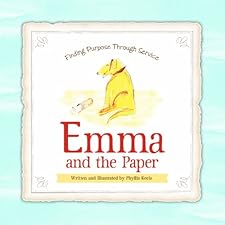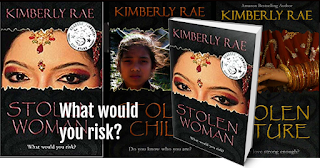Today's guest interview is with writer and illustrator Phyllis Keels. Phyllis is the author of the novel, The Lady of Daldriada, and the author and illustrator of the children's book, Emma and the Paper.

I loved Phyllis' paintings so much, I asked her to work with me on my upcoming book, When I'm With Jesus.
 |
| One of the paintings Phyllis has done for my book. |
Welcome, Phyllis! Tell us about when you started drawing.
I've dabbled in drawing most of my life, but never thought of myself as
an artist. In 2009 when I couldn't find anyone I could afford to
illustrate the children's book I had written in honor of my dad, I
decided to give it a shot.
What do you like about illustrating books?
Oh, the best part by far is reading the story for the first time and
getting to see the pictures in my head. That's how I know what to draw. I
have to make notes when that happens because sometimes the images come
pretty quickly and I don't want to forget them.
I
try to enjoy the process of how the images come to the paper while I'm
drawing. Instead of worrying about getting them just right, it's fun to
see them grow right in front of you.
Most authors can't illustrate their own books. Do you see advantages to being able to draw your own pictures?
Most authors can't illustrate their own books. Do you see advantages to being able to draw your own pictures?
Definitely. As the author, you have the best vision of your characters,
the settings, and the message you want to convey. If you can do your
own illustrations, even if you think they are not perfect, it's worth
doing it, even if you do it only once.
You
never know what will happen from that. I was certain that the book
design company for "Emma and the Paper" would not want to use my
illustrations. The first thing they said to me after seeing the original
hand-bound version I made for my dad was, "We love the illustrations!
We think they should stay."
Where can authors see some of your illustrations?
Where can authors see some of your illustrations?
The best examples of my work are in "Emma and the Paper". You can get to it from my website: phylliskeels.com or the Pinterest page for my books: pinterest.com/phylliskeels.
Do you illustrate for other authors? If so, do you charge a rate per picture, or share royalties after the book is published?
Do you illustrate for other authors? If so, do you charge a rate per picture, or share royalties after the book is published?
I sure do. I can do either a fixed rate for the project or share royalties.
Are you currently open to inquiries from authors? If so, how can authors contact you to consider illustrating their books?
Are you currently open to inquiries from authors? If so, how can authors contact you to consider illustrating their books?
Yes, I am open to inquiries and can be contacted through my website: phylliskeels.com
What do you think is unique about your illustrations/style?
What do you think is unique about your illustrations/style?
Probably the childlike quality in the drawings. When Emma and the Paper
came out, one comment I heard was, "Phyllis, there is such a tenderness
in this book." That's always a good thing to hear about a children's
book.
When
I've held book readings for children's groups, the children always
comment on how much they like the pictures. That is such a great feeling
- not being praised - but that they might be able to feel the love and
affection that went into those illustrations.
Were you a writer first or illustrator first?
Were you a writer first or illustrator first?
I was a writer first for sure. In the past, when I did draw, it was simply to draw, not to illustrate a story.
Which of the two is most enjoyable to you?
Which of the two is most enjoyable to you?
I enjoy both but for different reasons. Writing appeals to the adult in
me because of how characters develop, the choices they make, how they
honor one another and the Lord.
Illustrating
wakes up the child in me. There is a freedom in it that takes you back
to the innocence of childhood. That's always a great place to be.
Tell us a little of your personal story.
I
guess in a way I've been a writer all my life. I used to play in the
woods near our house, pretending I was off on an adventure in the middle
ages or another planet. Those years of daydreaming and pretending
prepared me to let the stories flow out onto paper when I grew up.
I
was close to giving up on writing during the busy years of working and
being a mom, but I didn't. Even though there were long periods of
drought where I wrote little or nothing, I always came back to it.
Yet,
it didn't take long for the Lord to show me just how tenderly He had
prepared me to be a writer, how He had carried me and loved me.
He
let me see the thread He had woven through my life, the thread that
brought me here - where I can use my gift to tell others how completely
faithful Jesus is.
Since
that time, I see writing as a lovely privilege, because it is almost as
if He sits with me while I write. I feel like the most blessed person
in the world.
Anything else you'd like to tell readers?
These things take time (finding out who you are, learning to use your
gifts). Enjoy the part where you are now, even if it's not where you
want to be.
One day you'll look back on this time and see how very sweet it was.
Thanks for joining us today, Phyllis!
Find out more about Phyllis Keels on her website, phylliskeels.com
or blog: The Gifted Writer
Subscribe up on the right side of this site to get Write With Purpose delivered to your inbox every week! Next week's post: How to NOT look Self-Published. Don't miss it!






